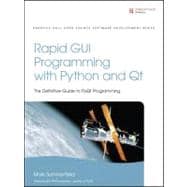
What is included with this book?
Mark Summerfield works as an independent trainer and consultant specializing in C++, Qt, Python, and PyQt. He was Trolltech’s documentation manager from 2000 to 2004, was the founding editor of Qt Quarterly, Trolltech’s customer newsletter, and coauthored C++ GUI Programming with Qt 3 and C++ GUI Programming with Qt 4.
| Data Types and Data Structures | p. 9 |
| Control Structures | p. 45 |
| Classes and Modules | p. 75 |
| Introduction to GUI Programming | p. 111 |
| Dialogs | p. 139 |
| Main Windows | p. 165 |
| Using Qt Designer | p. 205 |
| Data Handling and Custom File Formats | p. 227 |
| Layouts and Multiple Documents | p. 269 |
| Events, the Clipboard, and Drag and Drop | p. 303 |
| Custom Widgets | p. 321 |
| Item-Based Graphics | p. 349 |
| Rich Text and Printing | p. 381 |
| Model/View Programming | p. 413 |
| Databases | p. 445 |
| Advanced Model/View Programming | p. 475 |
| Online Help and Internationalization | p. 509 |
| Networking | p. 521 |
| Multithreading | p. 537 |
| Installing | p. 561 |
| Selected PyQt Widgets | p. 575 |
| Selected PyQt Class Hierarchies | p. 581 |
| Table of Contents provided by Blackwell. All Rights Reserved. |
The New copy of this book will include any supplemental materials advertised. Please check the title of the book to determine if it should include any access cards, study guides, lab manuals, CDs, etc.
The Used, Rental and eBook copies of this book are not guaranteed to include any supplemental materials. Typically, only the book itself is included. This is true even if the title states it includes any access cards, study guides, lab manuals, CDs, etc.